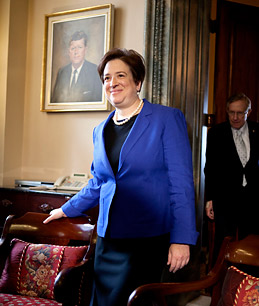
In the 1980s, Harvard Law School was known as “Beirut on the Charles.” Professors waged bitter tenure battles; students argued over issues like affirmative action.
That infighting found its way into Gannett House, home of the Harvard Law Review. In the 1985-86 year, its members were a fairly outspoken group: Jeffrey Toobin, the legal analyst; Miguel Estrada, a conservative lawyer whose federal judicial nomination would be blocked by Democrats in 2003 — and Elena Kagan. While many debated in a second-floor common room, the future Supreme Court nominee could usually be found in a quiet third-floor office, keeping the scholarly trains running on time.
Kagan returned to Harvard 13 years later as professor and then dean, and remained true to her student form. She focused on recruiting leading legal thinkers and upgrading the student experience, while sidestepping most of the academic warfare.
Throughout her career, as she has compiled a remarkable legal record, Kagan has won friends across the political spectrum. For that reason, her confirmation hearings, which begin June 28, are likely to be a cakewalk — and she may turn out to be an unusually effective justice. When John Paul Stevens, the leader of the court’s liberals, announced his retirement, liberals hoped for a bold progressive to replace him. Pragmatists wanted a moderate. Obama tapped Kagan, who had recently left Harvard to become his Solicitor General.
During her rise, she touched many liberal stations of the cross — progressive upbringing on Manhattan’s Upper West Side; clerkship for Justice Thurgood Marshall; jobs in the Clinton White House. But thanks to her bridge-building as dean — she recruited many top conservatives — marquee-name conservatives also back her. In recent years, presidents have looked for nominees with thin paper trails, and Kagan fits the bill. Despite years in public life, her views are surprisingly opaque. Her academic writings are mainly dry discourses. Thousands of her White House emails have been released, but they reveal little.
Liberal groups have largely embraced Kagan, who would raise the number of women on the court to three — an historical first. But they worry it is hard to be sure where she stands on basic issues like abortion rights.
On the surface, liberals would seem to have the most at risk. Kagan would replace one of the court’s most reliably left-leaning members. If she breaks rank on even a few issues, the court’s left-of-center bloc could erode further.
But conservatives could actually have more to lose. Kagan could be a powerful intellectual leader for the liberals, and adept at winning over conservative justices. This may be precisely why Obama chose her.
See the top 10 political gaffes of 2009.